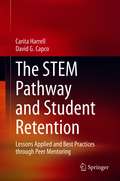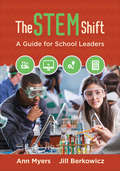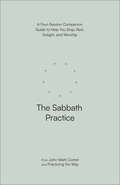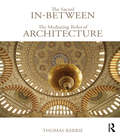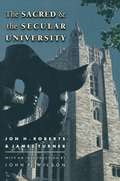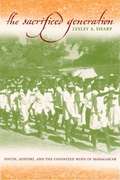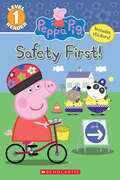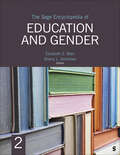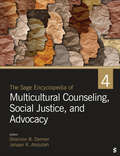- Table View
- List View
The STEM Pathway and Student Retention: Lessons Applied and Best Practices through Peer Mentoring
by David G. Capco Carita HarrellThis work introduces methods that aid in freshman retention (in the transition from high school and to remain in the university of origin) and orient them towards a successful career in science. Specific examples of successful approaches are given as well as detailed plans for how to engage these students. Pitfalls as well as success are described. In addition this work provides a detailed description of how to develop the students into a cohort that exhibits comradery. Three types of cohort form, those within the freshman class, those among the upperclassmen and those between the freshmen and upperclassmen. The program works because the social reality is that the peer mentor has a better repertoire with the first semester freshmen than the faculty or staff and assists with student success. Factors such as financial aid, policy, and support systems influence student success. In the sciences, students often struggle with the content and adjusting to the college experience. Research states that a mentorship program supports retention as well as enhances the student experience during college. This program creates a cohort group among the upperclassmen mentors and freshmen and provides leadership development for all involved.
The STEM Shift: A Guide for School Leaders
by Ann P. Myers Jill BerkowiczAll you need to make the shift to STEM a reality! Now more than ever, educational leaders are encouraged to implement STEM as the foundation for preparing students with the 21st century skills required for college and career readiness. This resource makes the process of shifting to a comprehensive, integrated STEM school or district within reach! Invaluable case studies featuring current STEM pioneers from across the country model how successful, STEM-centered learning takes place. You’ll find process-specific best practices and strategies to help you: Understand, create, and lead the STEM change process Transform existing school programs Prepare the school community for STEM and plan for STEM integration Integrate 21st Century Skills, the arts, and humanities Create essential partnerships with business and higher education Includes step-by-step checklists and visual mapping guides for successfully navigating the STEM change process. Use this groundbreaking resource to systematically implement coherent and integrated STEM instruction that transforms learning and prepares students for the global economy! Video and web content also available at http://bit.ly/TheSTEMShift. "Finally! A great book that clearly explains what STEM education is, why we need it, and how to do it well. A must-read for all educators, parents, and policymakers." Tony Wagner, author of The Global Achievement Gap and Creating Innovators "Reading Jill and Ann′s column in Education Week has been a critical part of my weekly reading since they′ve begun writing it. I′ve learned a lot from those short snippets, and now it′s exciting to see their expanded thoughts in The Stem Shift. You can′t go wrong by reading anything they write!" Larry Ferlazzo, High school teacher and Ed Week columnist
The STEM Shift: A Guide for School Leaders
by Ann P. Myers Jill BerkowiczAll you need to make the shift to STEM a reality! Now more than ever, educational leaders are encouraged to implement STEM as the foundation for preparing students with the 21st century skills required for college and career readiness. This resource makes the process of shifting to a comprehensive, integrated STEM school or district within reach! Invaluable case studies featuring current STEM pioneers from across the country model how successful, STEM-centered learning takes place. You’ll find process-specific best practices and strategies to help you: Understand, create, and lead the STEM change process Transform existing school programs Prepare the school community for STEM and plan for STEM integration Integrate 21st Century Skills, the arts, and humanities Create essential partnerships with business and higher education Includes step-by-step checklists and visual mapping guides for successfully navigating the STEM change process. Use this groundbreaking resource to systematically implement coherent and integrated STEM instruction that transforms learning and prepares students for the global economy! Video and web content also available at http://bit.ly/TheSTEMShift. "Finally! A great book that clearly explains what STEM education is, why we need it, and how to do it well. A must-read for all educators, parents, and policymakers." Tony Wagner, author of The Global Achievement Gap and Creating Innovators "Reading Jill and Ann′s column in Education Week has been a critical part of my weekly reading since they′ve begun writing it. I′ve learned a lot from those short snippets, and now it′s exciting to see their expanded thoughts in The Stem Shift. You can′t go wrong by reading anything they write!" Larry Ferlazzo, High school teacher and Ed Week columnist
The STEWARD Plan: Understanding God's Design for Your Finances
by John A. Madison, CPA.Does the Bible really offer guidance for the complicated financial system in our world today? CPA, author and personal financial counselor John Madison offers a resounding yes! Since retiring from full-time work as a CPA at the age of 49, he has written his new book, The Steward Plan, which explores how following Biblical guidelines can lead people at any stage of life to financial success God&’s way.The Steward Plan covers many aspects of becoming the financial steward God desires, including how to set financial goals, tithing guidance and strategies, creating a blueprint for spending, eliminating debt from your life, growing your wealth wisely over time, removing unnecessary risk from your financial life, and developing a plan to bless future generations. Combining Scripture with practical and easy-to-understand financial terms, The Steward Plan will help you gain control over your money and live the life God designed for you.The Steward Plan is an outgrowth of Dayspring Financial Ministry, whose mission is to teach Biblical financial stewardship. Like all of Dayspring&’s programs, The Steward Plan does not promote or attempt to sell any specific insurance or investing products. It is an independent source of financial information and education, free of any bias, other than conformity with Scripture.
The Sabbath Practice: A Four-Session Companion Guide to Help You Stop, Rest, Delight, and Worship
by Practicing the Way John Mark ComerIn our era of chronic exhaustion, learn how setting aside 24 hours to stop, rest, delight, and worship restores joy and spiritual vitality in this guide from New York Times bestselling author John Mark Comer and the team at Practicing the Way.This Companion Guide to the Sabbath Practice from Practicing the Way provides a practical, accessible approach to incorporating this life-giving rhythm into your weekly routine. Designed to be used with four engaging video sessions freely available online, this guide offers spiritual exercises, reflection questions, and additional resources to help you and your community experience Sabbath as the best part of your week.This guide will help you:• Understand the biblical foundations of Sabbath• Learn to &“stop&” and align with a rhythm God built into the fabric of creation• Develop personal practices for meaningful rest, play, and communal celebration• Resist internal and external forces that war against Sabbath• Cultivate a spirit of worship that extends throughout your weekDiscover how setting aside 24 hours can transform every day of your week, leading to a deeper connection with God, others, and your own soul.
The Saboteur at Work: How the Unconscious Mind Can Sabotage Ourselves, Our Organisations and Society
by Michael DraytonThe Saboteur at Work describes how unconscious psychological processes can sabotage individual lives, the functioning of groups, teams and organisations, and even global politics. Drawing on research in the fields of psychology and organisations, this comprehensive yet straightforward and accessible book enables you to understand how the unconscious can impact progress and performance and describes practical techniques you can use to overcome the saboteur, individually and at work. The book discusses the modern understanding of our adaptive unconscious, and you will learn about repression, imposter syndrome and other defence mechanisms. Ideas are brought to life using real-world examples and personal, organisational and national stories. The book explores the mind’s capacity for self-deception by telling the story of Tony Blair and the invasion of Iraq and looks at unconscious processes in organisations, asking what role the saboteur played in huge corporate failures such as the collapse of Barings Bank and the Boeing 737 Max scandal. The saboteur also operates on a larger scale – governments and societies can be sabotaged by this unconscious force. In Nazi Germany, how did normal, decent people behave like monsters, colluding with or actively participating in the murder of innocent people? Why did big US corporates like IBM, Ford and Chrysler work with the Nazis to make the Holocaust possible? If you manage a team or lead an organisation, you need to understand the role played by the saboteur in your workplace and in your own career and life. This book enables leaders and managers to develop their leadership skills by understanding how the unconscious impacts individual, group and social processes. It will also be of use to coaches and organisational consultants working in the areas of teams and performance.
The Sacred In-Between: The Mediating Roles of Architecture
by Thomas BarrieThe sacred place was, and still is, an intermediate zone created in the belief that it has the ability to co-join the religious aspirants to their gods. An essential means of understanding this sacred architecture is through the recognition of its role as an ‘in-between’ place. Establishing the contexts, approaches and understandings of architecture through the lens of the mediating roles often performed by sacred architecture, this book offers the reader an extraordinary insight into the forces behind these extraordinary buildings. Written by a well-known expert in the field, the book draws on a unique range of cases, reflecting on these inspiring places, their continuing ontological significance and the lessons they can offer today. Fascinating reading for anyone interested in sacred architecture.
The Sacred Romance Workbook, Updated Edition: Coming Home to the God Who Pursues Your Heart
by John EldredgeThe voice catches us off guard, whether in the middle of the day or the dead of night. It is the voice of God, wooing our hearts with words that seem too good to be true. Listen to me—there is something missing. You long to be in a love affair, a great adventure. You were made for more. You know it.Yet another voice, often louder, competes for our attention. The Message of the Arrows has assaulted us since childhood. The enemy knows if he can get us to lose heart, we will lose everything. How are we to make sense of these terribly opposed messages?The Sacred Romance pulls the curtain back on the cosmic drama that God's been weaving since before time began. In this updated edition, you will discover:How your current life is far too safe compared to the larger story God has for you;How to know God as the Great Romancer and embrace his love for you;How the enemy tries to destroy you through the Message of the Arrows; andHow to enter into and remain in the Sacred Romance with Jesus.This workbook is a companion to The Sacred Romance by John Eldredge and is a guided journey filled with questions, exercises, journaling ideas, and explorations of the arts that will take you into the heart of God and lead to the recovery of your own heart.
The Sacred and the Secular University (The William G. Bowen Series #34)
by James Turner Jon H. RobertsAmerican higher education was transformed between the end of the Civil War and the beginning of World War I. During this period, U.S. colleges underwent fundamental changes--changes that helped to create the modern university we know today. Most significantly, the study of the sciences and the humanities effectively dissolved the Protestant framework of learning by introducing a new secularized curriculum. This secularization has long been recognized as a decisive turning point in the history of American education. Until now, however, there has been remarkably little attention paid to the details of how this transformation came about. Here, at last, Jon Roberts and James Turner identify the forces and explain the events that reformed the college curriculum during this era.The first section of the book examines how the study of science became detached from theological considerations. Previously, one of the primary pursuits of "natural scientists" was to achieve an understanding of the workings of the divine in earthly events. During the late nineteenth century, however, scientists reduced the scope of their inquiries to subjects that could be isolated, measured, and studied objectively. In pursuit of "scientific truth," they were drawn away from the larger "truths" that they had once sought. On a related path, social scientists began to pursue the study of human society more scientifically, attempting to generalize principles of behavior from empirically observed events.The second section describes the revolution that occurred in the humanities, beginning in the mid-nineteenth century, when the study of humanities was largely the study of Greek and Latin. By 1900, however, the humanities were much more broadly construed, including such previously unstudied subjects as literature, philosophy, history, and art history. The "triumph of the humanities" represented a significant change in attitudes about what constituted academic knowledge and, therefore, what should be a part of the college curriculum.The Sacred and the Secular University rewrites the history of higher education in the United States. It will interest all readers who are concerned about American universities and about how the content of a "college education" has changed over the course of the last century."[Jon Roberts and James Turner's] thoroughly researched and carefully argued presentations invite readers to revisit stereotypical generalizations and to rethink the premises developed in the late nineteenth century that underlie the modern university. At the least, their arguments challenge crude versions of the secularization thesis as applied to higher education."--From the foreword by William G. Bowen and Harold T. Shapiro
The Sacrificed Generation: Youth, History, and the Colonized Mind in Madagascar
by Lesley A. SharpYouth, historical consciousness, and political agency in independent Francophone Africa are the themes that frame this study about Madagascar.
The Safety First! (Scholastic Reader, Level 1)
by Courtney CarbonePeppa Pig and her class learn all about safety in this Level 1 reader with stickers, based on the hit Nick Jr. TV show!Police Officer Panda and Police Officer Squirrel are visiting Peppa's class for an important lesson on safety!This Level 1 beginning reader is based on the hit Nick Jr. television show.
The Sage Encyclopedia of Education and Gender
by Sherry L. Deckman Elizabeth E. BlairGender is a prominent and often-contested issue in educational settings across the globe. While understandings of gender and academic and professional potential, roles and expectations, and opportunities and abilities have greatly expanded over the past century in various contexts, schools remain sites of intense conflict around definitions of gender and gendered access and expression. For example, in the US there is growing public backlash against recognizing gender diversity in schools, with educators being called to make their teaching more inclusive, while schools debate what representations are permissible and parents bring legal action against school districts over recognizing students’ chosen gender expression. Furthermore, educational access and outcomes have nuanced gendered patterns to which educators and educational researchers must be attentive. For example, in India, growing literacy rates among youth now show gender parity, while across age groups men show higher literacy rates than women. In Afghanistan, girls have recently been restricted from attending school. Globally, school attendance among youth who menstruate is reduced because of lack of access to menstrual health products. In the US (and many Western countries), women are more likely to graduate high school and college than men, with the US showing the greatest degree attainment disparities between women and men of color. However, US women still advance in STEM fields at persistently lower rates than men, a pattern contrasted by the rapid rise of women earning the majority of STEM degrees in China. These examples begin to show the nuance of gendered educational patterns, with perspectives growing in complexity as our understandings of gender shift and change, moving beyond the traditional gender binary. Yet, despite rapid changes in gendered educational patterns and in how education scholars conceptualize and study gender, the field lacks a recent, comprehensive resource text. This two-volume encyclopedia, a unique compendium on gender and education with an expansive and inclusive approach, will address this urgent need. Featuring a broad range of 250-300 well-researched, short articles written by global experts in the field, this much-needed guide will be an essential, first-stop resource for students and scholars exploring issues of gender and education, as well as educators caught in a rapidly changing and nuanced field. A central strength of this encyclopedia will be its broad, nuanced, and inclusive exploration of gender. Entries will explore topics of gender and education comprehensively, through an intersectional lens, covering issues of gender equity, identity, and inclusivity in education that impact women, girls, men, boys, trans, genderqueer, and nonbinary people. As education is an interdisciplinary field, the Encyclopedia will draw from perspectives in sociology, anthropology, psychology, policy studies, leadership, philosophy, history, economics, law, curriculum studies, public health, race & ethnic studies, and women, gender, & queer studies.
The Sage Encyclopedia of Education and Gender
by Sherry L. Deckman Elizabeth E. BlairGender is a prominent and often-contested issue in educational settings across the globe. While understandings of gender and academic and professional potential, roles and expectations, and opportunities and abilities have greatly expanded over the past century in various contexts, schools remain sites of intense conflict around definitions of gender and gendered access and expression. For example, in the US there is growing public backlash against recognizing gender diversity in schools, with educators being called to make their teaching more inclusive, while schools debate what representations are permissible and parents bring legal action against school districts over recognizing students’ chosen gender expression. Furthermore, educational access and outcomes have nuanced gendered patterns to which educators and educational researchers must be attentive. For example, in India, growing literacy rates among youth now show gender parity, while across age groups men show higher literacy rates than women. In Afghanistan, girls have recently been restricted from attending school. Globally, school attendance among youth who menstruate is reduced because of lack of access to menstrual health products. In the US (and many Western countries), women are more likely to graduate high school and college than men, with the US showing the greatest degree attainment disparities between women and men of color. However, US women still advance in STEM fields at persistently lower rates than men, a pattern contrasted by the rapid rise of women earning the majority of STEM degrees in China. These examples begin to show the nuance of gendered educational patterns, with perspectives growing in complexity as our understandings of gender shift and change, moving beyond the traditional gender binary. Yet, despite rapid changes in gendered educational patterns and in how education scholars conceptualize and study gender, the field lacks a recent, comprehensive resource text. This two-volume encyclopedia, a unique compendium on gender and education with an expansive and inclusive approach, will address this urgent need. Featuring a broad range of 250-300 well-researched, short articles written by global experts in the field, this much-needed guide will be an essential, first-stop resource for students and scholars exploring issues of gender and education, as well as educators caught in a rapidly changing and nuanced field. A central strength of this encyclopedia will be its broad, nuanced, and inclusive exploration of gender. Entries will explore topics of gender and education comprehensively, through an intersectional lens, covering issues of gender equity, identity, and inclusivity in education that impact women, girls, men, boys, trans, genderqueer, and nonbinary people. As education is an interdisciplinary field, the Encyclopedia will draw from perspectives in sociology, anthropology, psychology, policy studies, leadership, philosophy, history, economics, law, curriculum studies, public health, race & ethnic studies, and women, gender, & queer studies.
The Sage Encyclopedia of Multicultural Counseling, Social Justice, and Advocacy
by Shannon B. Dermer Jahaan R. AbdullahSince the late 1970s, there has been an increase in the study of diversity, inclusion, race, and ethnicity within the field of counseling. The SAGE Encyclopedia of Multicultural Counseling, Social Justice, and Advocacy will comprehensively synthesize a wide range of terms, concepts, ideologies, groups, and organizations through a diverse lens. This encyclopedia will include entries on a wide range of topics relative to multicultural counseling, social justice and advocacy, and the experiences of diverse groups. The encyclopedia will consist of approximately 600 signed entries, arranged alphabetically within four volumes.
The Sage Encyclopedia of Multicultural Counseling, Social Justice, and Advocacy
by Shannon B. Dermer Jahaan R. AbdullahSince the late 1970s, there has been an increase in the study of diversity, inclusion, race, and ethnicity within the field of counseling. The SAGE Encyclopedia of Multicultural Counseling, Social Justice, and Advocacy will comprehensively synthesize a wide range of terms, concepts, ideologies, groups, and organizations through a diverse lens. This encyclopedia will include entries on a wide range of topics relative to multicultural counseling, social justice and advocacy, and the experiences of diverse groups. The encyclopedia will consist of approximately 600 signed entries, arranged alphabetically within four volumes.
The Sage Handbook of Higher Education Instructional Design
by Safary Wa-Mbaleka Baiyun Chen Gianina-Estera Petre Aimee DeNoyellesWith contributions from leading experts and emerging voices in the field, The Sage Handbook of Higher Education Instructional Design is an indispensable resource for anyone engaged in the evolving practice of instructional design in higher education. This handbook explores innovative applications and provides comprehensive guidance on integrating instructional design principles across diverse educational contexts. It highlights how design innovations can address the unique challenges of higher education and contribute to enhancing learning experiences. This handbook is essential for instructional designers, team leaders, university students, online education leaders, researchers, faculty, and support personnel. It covers a wide range of institutions and program formats, including online, face-to-face, blended, and hybrid environments. By focusing on the practicalities of instructional design, this handbook prepares educators and designers to adapt to the dynamic conditions of modern higher education. Whether you are directly involved in instructional design or seeking to understand its impact on higher education, this handbook offers valuable insights and practical guidance to navigate and excel in this evolving field. Section 1: Foundations of Higher Education Instructional Design Section 2: Instructional Design Theories and Models Section 3: Practical Strategies and Methods Section 4: Instructional Design Scenarios Section 5: Curriculum-Level Issues Section 6: Instructional Technology Tools Section 7: Research in Higher Education Instructional Design
The Sage Handbook of Higher Education Instructional Design
by Safary Wa-Mbaleka Baiyun Chen Gianina-Estera Petre Aimee DeNoyellesWith contributions from leading experts and emerging voices in the field, The Sage Handbook of Higher Education Instructional Design is an indispensable resource for anyone engaged in the evolving practice of instructional design in higher education. This handbook explores innovative applications and provides comprehensive guidance on integrating instructional design principles across diverse educational contexts. It highlights how design innovations can address the unique challenges of higher education and contribute to enhancing learning experiences. This handbook is essential for instructional designers, team leaders, university students, online education leaders, researchers, faculty, and support personnel. It covers a wide range of institutions and program formats, including online, face-to-face, blended, and hybrid environments. By focusing on the practicalities of instructional design, this handbook prepares educators and designers to adapt to the dynamic conditions of modern higher education. Whether you are directly involved in instructional design or seeking to understand its impact on higher education, this handbook offers valuable insights and practical guidance to navigate and excel in this evolving field. Section 1: Foundations of Higher Education Instructional Design Section 2: Instructional Design Theories and Models Section 3: Practical Strategies and Methods Section 4: Instructional Design Scenarios Section 5: Curriculum-Level Issues Section 6: Instructional Technology Tools Section 7: Research in Higher Education Instructional Design
The Sage Handbook of Nursing Education
by Carol Hall Patricia S. Yoder-Wise Mary Gobbi Kathryn Whitcomb ParkerIn the past several years, a revival of research devoted to nursing education has emerged. This emergence has changed the way many educators engage in their practice of working with learners; and learners have come to expect that they will have a rich learning experience designed to develop new (or enhance prior) knowledge, skills, and attitudes. The SAGE Handbook of Nursing Education provides a detailed map of the current discipline, with a carefully selected team of international contributors offering the latest thinking about education in nursing across key areas. This handbook will be a key resource for academic educators, as well as graduate and postgraduate learners.
The Sage Handbook of Nursing Education
by Carol Hall Patricia S. Yoder-Wise Mary Gobbi Kathryn Whitcomb ParkerIn the past several years, a revival of research devoted to nursing education has emerged. This emergence has changed the way many educators engage in their practice of working with learners; and learners have come to expect that they will have a rich learning experience designed to develop new (or enhance prior) knowledge, skills, and attitudes. The SAGE Handbook of Nursing Education provides a detailed map of the current discipline, with a carefully selected team of international contributors offering the latest thinking about education in nursing across key areas. This handbook will be a key resource for academic educators, as well as graduate and postgraduate learners.
The Sage Handbook of Online Higher Education
by Safary Wa-Mbaleka Kelvin Thompson Leni CasimiroThe SAGE Handbook of Online Higher Education presents a cutting-edge collection of 50 essays that explores the rapidly evolving landscape of online teaching and learning in higher education. Assembled and contributed by a team of leading experts, the Handbook adopts a uniquely holistic approach to examining the needs of online education. Chapters bring together voices from diverse and international backgrounds to provide insights applicable to a broad range of contexts, and present practical strategies for planning, delivering quality online higher education. The handbook covers a wide range of topics, including online pedagogy, instructional design, student engagement, technological innovation, assessment, leadership, and the developing role of online education in the context of broader societal and cultural shifts. The SAGE Handbook of Online Higher Education is an essential resource for educators, researchers, policymakers, and practitioners who seek to understand and shape the future of higher education in the digital age. Section 1: Fundamentals of Online Education Section 2: Online Education Around the World Section 3: Online Instructional Design Section 4: Online Instructional Delivery Section 5: Instructional Technology for Online Education Section 6: Online Education Administration and Management Section 7: Student Support Services
The Sage Handbook of Online Higher Education
by Safary Wa-Mbaleka Kelvin Thompson Leni CasimiroThe SAGE Handbook of Online Higher Education presents a cutting-edge collection of 50 essays that explores the rapidly evolving landscape of online teaching and learning in higher education. Assembled and contributed by a team of leading experts, the Handbook adopts a uniquely holistic approach to examining the needs of online education. Chapters bring together voices from diverse and international backgrounds to provide insights applicable to a broad range of contexts, and present practical strategies for planning, delivering quality online higher education. The handbook covers a wide range of topics, including online pedagogy, instructional design, student engagement, technological innovation, assessment, leadership, and the developing role of online education in the context of broader societal and cultural shifts. The SAGE Handbook of Online Higher Education is an essential resource for educators, researchers, policymakers, and practitioners who seek to understand and shape the future of higher education in the digital age. Section 1: Fundamentals of Online Education Section 2: Online Education Around the World Section 3: Online Instructional Design Section 4: Online Instructional Delivery Section 5: Instructional Technology for Online Education Section 6: Online Education Administration and Management Section 7: Student Support Services
The Sage Handbook of School Music Education
by Catharina Christophersen José Luis Aróstegui Jeananne Nichols Koji MatsunobuThe Sage Handbook of School Music Education stands as an essential guide for navigating the evolving educational landscape in the wake of the 2008 financial crisis and the transformative impact of the COVID-19 pandemic. The handbook addresses philosophical foundations, social justice challenges, the envisioning of a transformative curriculum, and critical issues in music teacher education. Written by a diverse team of leading scholars, this handbook offers a truly global perspective with contributors from Africa, Asia, Australasia, Europe, and North and South America. The handbook engages with the profound interplay of economic, political, and social forces that shape educational policies. Scholars within this collaborative work delve into what it means to educate in a world undergoing significant changes. This entails an exploration of emerging educational approaches, considerations for societal implications, and the interconnectedness of school music education with broader curricular and global contexts. As a cohesive resource, The Sage Handbook of School Music Education not only addresses the challenges faced by educators but also envisions the transformative potential of music education in fostering creativity, inclusivity, and adaptability. This handbook serves as a compass for students, practitioners and scholars in the field, and all those passionate about navigating the complexities of redefining music education for a new era. Part 1: Foundations Part 2: Struggling for Social Justice Through Music Education Part 3: Curriculum Development Part 4: Teacher Education
The Sage Handbook of School Music Education
by Catharina Christophersen José Luis Aróstegui Jeananne Nichols Koji MatsunobuThe Sage Handbook of School Music Education stands as an essential guide for navigating the evolving educational landscape in the wake of the 2008 financial crisis and the transformative impact of the COVID-19 pandemic. The handbook addresses philosophical foundations, social justice challenges, the envisioning of a transformative curriculum, and critical issues in music teacher education. Written by a diverse team of leading scholars, this handbook offers a truly global perspective with contributors from Africa, Asia, Australasia, Europe, and North and South America. The handbook engages with the profound interplay of economic, political, and social forces that shape educational policies. Scholars within this collaborative work delve into what it means to educate in a world undergoing significant changes. This entails an exploration of emerging educational approaches, considerations for societal implications, and the interconnectedness of school music education with broader curricular and global contexts. As a cohesive resource, The Sage Handbook of School Music Education not only addresses the challenges faced by educators but also envisions the transformative potential of music education in fostering creativity, inclusivity, and adaptability. This handbook serves as a compass for students, practitioners and scholars in the field, and all those passionate about navigating the complexities of redefining music education for a new era. Part 1: Foundations Part 2: Struggling for Social Justice Through Music Education Part 3: Curriculum Development Part 4: Teacher Education
The Sage Handbook of Sociology of Education
by Mark Berends Barbara Schneider Stephen LambThe Sage Handbook of Sociology of Education is an international and comprehensive groundbreaking text that serves as a touchstone for researchers and scholars interested in exploring the intricate relationships between education and society. Leading sociologists from five different continents examine major topics in sociology from a global perspective. This timely, thought-provoking Handbook features contributions from leading and emerging sociology scholars, who provide their own cultural and historical perspectives on diverse—yet universal—topics; these include educational policy, social stratification, and cross-national research. 39 Chapters delve into the pressing issues faced by our global society, such as the effects of residential mobility on educational outcomes, gender and ethnic inequalities, and the impact of COVID-19 on early childhood education. Readers will gain a multifaceted view of the contours of educational inequality, from various international perspectives and focusing on country differences, as well as recommendations for expanding the practices, programs, and policies that could reduce the rising tide of inequities—especially for populations most at risk. This Handbook offers rich, diverse perspectives on the interplay between education, social inequality, and human rights around the world, making it an invaluable resource for students, researchers, and practitioners across a range of fields, including sociology, education, and social policy. PART 1: Education and Persistent Inequality PART 2: Social & Family Contexts PART 3: Schools & Educational Policy PART 4: Neighborhoods & Community PART 5: Education & Innovation in a Global Context
The Sage Handbook of Sociology of Education
by Mark Berends Barbara Schneider Stephen LambThe Sage Handbook of Sociology of Education is an international and comprehensive groundbreaking text that serves as a touchstone for researchers and scholars interested in exploring the intricate relationships between education and society. Leading sociologists from five different continents examine major topics in sociology from a global perspective. This timely, thought-provoking Handbook features contributions from leading and emerging sociology scholars, who provide their own cultural and historical perspectives on diverse—yet universal—topics; these include educational policy, social stratification, and cross-national research. 39 Chapters delve into the pressing issues faced by our global society, such as the effects of residential mobility on educational outcomes, gender and ethnic inequalities, and the impact of COVID-19 on early childhood education. Readers will gain a multifaceted view of the contours of educational inequality, from various international perspectives and focusing on country differences, as well as recommendations for expanding the practices, programs, and policies that could reduce the rising tide of inequities—especially for populations most at risk. This Handbook offers rich, diverse perspectives on the interplay between education, social inequality, and human rights around the world, making it an invaluable resource for students, researchers, and practitioners across a range of fields, including sociology, education, and social policy. PART 1: Education and Persistent Inequality PART 2: Social & Family Contexts PART 3: Schools & Educational Policy PART 4: Neighborhoods & Community PART 5: Education & Innovation in a Global Context
